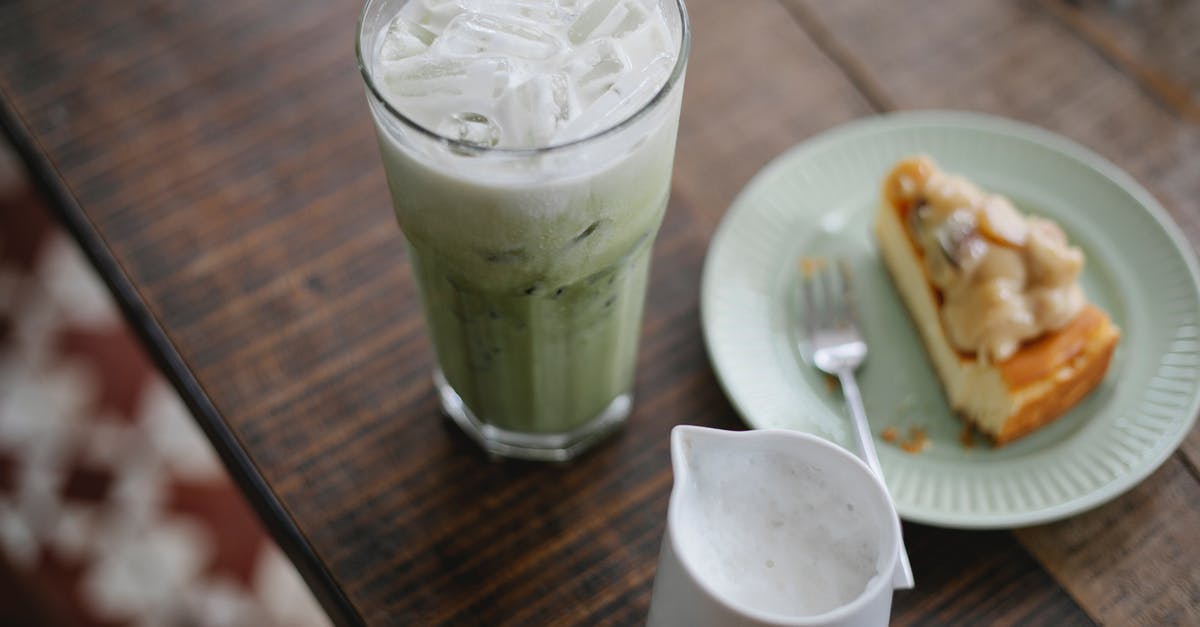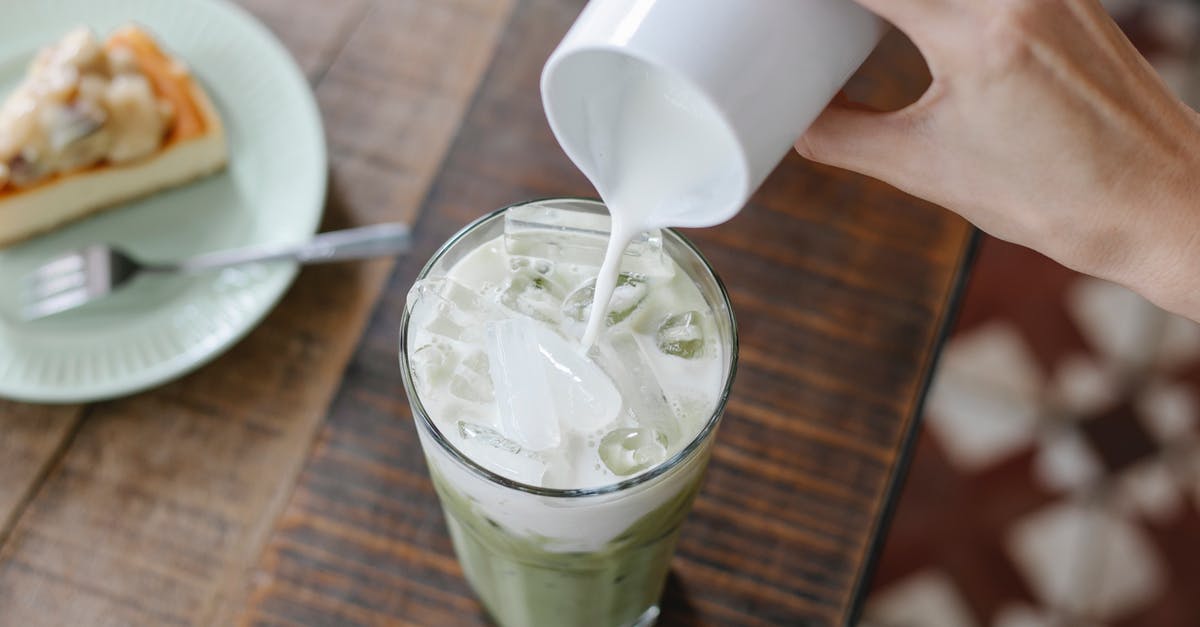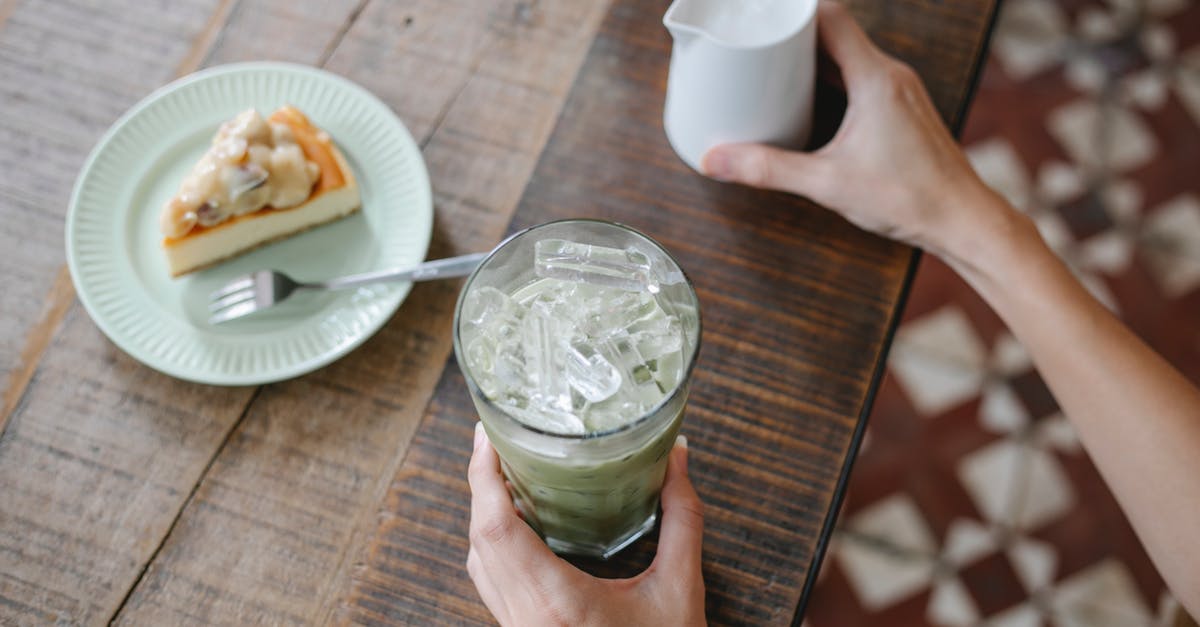"Sludge" at the bottom of matcha/green tea latte

When I get a green tea latte from Starbucks, the drink is uniformly mixed from top to bottom, no matter how long it takes me to drink it.
I prefer to make my matcha lattes at home, though, because its faster, cheaper, and better (both health and taste, as I prefer my lattes far less sweet than Starbucks makes them and I prefer to sweeten with honey) than running through the drive through every morning. However, every morning, no matter how fast I drink my morning beverage, I wind up with a layer of green sludge at the bottom of my cup.
From what I can tell, the matcha is falling out of solution with the rest of the drink, despite being thoroughly mixed to start out. I do wonder if it has something with the amount of sugar, or the use of water to dissolve the matcha in. But since the whole thing comes together and tastes wonderful (until the last bit), I'm not sure. The only way around it I've found so far is to stir the drink well before every sip, which is unnecessary with coffee house versions (as I've had them other places and do not recall winding up with sludge at the end of the drink) and annoying while I'm at work.
Why do my matcha lattes end in green sludge, and how can I fix it? The green sludge at the end is bitter, thick, and unpleasant to drink, so I want to make my latte more like the ones from a coffee shop.
Recipe and method:
3/4 - 1 cup milk (depending on mug size), heated
1 slightly heaping teaspoon matcha powder
1 - 2 teaspoons honey
~1/8 cup hot water (a minute or two off the boil)
Force matcha through a sieve into mug to remove lumps, add hot water. Blend (using electric whisk/milk frother) until dissolved. Add honey, blend again to dissolve. Froth milk, then add to mug. Blend to mix milk and tea/honey mixture. Drink.
Best Answer
If you are making your drink with real matcha, that matcha is very finely ground green tea leaves. There are parts of the tea leaves that will always be insoluble in water, and therefore eventually fall to the bottom and create this sludge to which you are referring. The only solutions to that issue would be either 1) filtering the solution to remove the insoluble solids or 2) allowing the insoluble solids to settle to the bottom and the decanting the beverage above that sludge into another container. Straining is not enough when you are dealing with very fine particles, as the openings in strainers would just allow those particles to pass right through.
If, however, you are not using real matcha and it is completely water soluble (maybe a freeze-dried preparation from brewed tea) there will be no sludge. I would suspect that Starbucks is not brewing green tea with real matcha for every serving.
Pictures about ""Sludge" at the bottom of matcha/green tea latte"



Why does my matcha settle at the bottom?
You will always find matcha powder fall to the bottom of the cup if you leave your matcha tea for too long. When you whisk the matcha, you actually create suspension of the tea leaf powder in the water, not dissolving it. Matcha powder has slight electrostatic energy, making it clump and form lumps.How do you get rid of lumps on matcha?
The best way to avoid clumps is to sift your matcha through a stainless steel tea strainer or sieve. It's a super easy step that only takes a few seconds. Simply place the stainless steel strainer over your cup or tea bowl and use a tea scoop (or spoon) to gently sift the matcha.Why are there clumps in my matcha?
If your matcha powder has been exposed to moisture, condensation or heat you will notice that the quality of the powder will deteriorate, causing the powder to clump together. Also, keep in mind that true Matcha powder is simply finely ground shade-grown tea leaves, without the addition of anti-clumping agents.Why does my matcha latte taste powdery?
The water might have been too hot; you might have used too much powder (if it's kind of chalky tasting). The matcha powder might be past its best before date, or lost its prime due to environmental factors.Matcha - what evidence is there to back up the health claims?
More answers regarding "Sludge" at the bottom of matcha/green tea latte
Answer 2
Use the milk frother but skip many of your steps (warm water unnecessary for example). First add the milk (oat milk works even better!) and turn on the frother, then, while the frother is on, add matcha powder gradually but make sure to finish a few seconds before the frother stops. If the powder has been exposed to moisture and is a bit clumpy you want to run it through a small sieve as you add it to the frother. I never add sweeteners so do not know when to add (perhaps try making one without sweetener to see if that helps), but I would do that after I have added the matcha to ensure the matcha is as well integrated as possible. I never have sludge except when I have clumpy matcha and no sieve. Most frothers have a cold whisk function you can use in case you did not finish all steps before the frother shuts off.
Answer 3
I make iced oat milk honey matcha lattes every day and don’t really have issues with sludge unless I leave my drink for a long period of time. My method is:
- microwave around 2 oz of water with 2-3 tsp honey for about 45 seconds (depends on microwave strength... can’t let it get to boiling heat or it will scorch the matcha and make it taste like an evil potion)
- while water is heating, I sift a teaspoon of matcha into a matcha chawan/bowl via an inexpensive stainless mesh matcha sifter
- pour the heated honey water (should be around 150-175 degrees, but under no circumstance should your milk or water be hotter than this for matcha) over the sifted matcha and whisk it rapidly with a matcha chasen for around a minute or two until light and frothy (there are tons of videos on whisking matcha out there)... proper aeration and separation of the little tea particles is your best defense against sludge
- shake up some oatly barista until it’s frothy and pour it over ice, and then pour the matcha over it; I also like to drink my lattes out of a mason jar with a Cuppow lid so I can just cover the top with my fingers and shake it up well before drinking. For hot lattes just pour the matcha over your appropriately heated milk.
- rinse off the matcha chasen and chawan with warm water, fill the chawan with warm water and whisk the chasen in it to clean off any residual stuff, dump everything out and lay it out to dry (benefit of using a chasen stand is that it can help ensure your chasen doesn’t get gross or moldy and will last a long time)
I really think your sludge issue is probably due to your whisking method, but if you are using low quality matcha (like culinary grade), I imagine those leaves might be a little heavier and more likely to create sludge at the bottom.
This is the chawan I have: Traditional Japanese Matcha Tea Cup Bowl | Multicolor Black Ceramic Ceremonial Chawan | Handcrafted, Lead Free, Large Macha Drinking Glass | Authentic Mug Shape https://smile.amazon.com/dp/B07Y1Z6SS3/ref=cm_sw_r_cp_api_fabc_Xy4PFbV5WPNGY I love that it’s shaped so that I can whisk matcha rapidly and not get matcha splashes anywhere
This is the chasen set I have: Matcha Tea Whisk Set - Bamboo Chasen and Black Whisk Holder Rest Set https://smile.amazon.com/dp/B07TKCQHHD/ref=cm_sw_r_cp_api_fabc_SD4PFbJH4D2W6 It whisks really well and the tines hold their curled shape for months and months so it does a beautiful job of aerating it
Sources: Stack Exchange - This article follows the attribution requirements of Stack Exchange and is licensed under CC BY-SA 3.0.
Images: Charlotte May, Charlotte May, Charlotte May, Charlotte May
